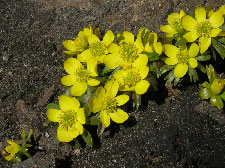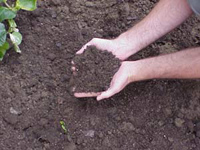
Winter aconite is a harbinger of spring.
The arrival of spring makes gardeners rejoice. The sun is warmer, buds swell, and the early bulbs like winter aconite are in full glory. Another sign of spring is gardeners starting to rake and hoe and dig in soil amendments and organic matter. Spring is a good time to improve soil in your garden so your plants grow healthy and can reach their full potential in the upcoming season.
The level of soil nutrients (minerals) is constantly in flux. Plant roots take up nutrients, and some nutrients are easily washed away by rain and irrigation. Nature replenishes them through decomposition of plant and animal matter (leaves, roots, bones, scat), atmospheric deposition (rainfall, snow, dust storms), and the dissolution of rock into its mineral components. Some of these natural processes take decades and will not be able to maintain equilibrium in your garden. This is especially true if you grow heavy feeders like fruits and vegetable crops, sunflowers, daffodils, and lilies. Their vigor and productivity will decline over time without the addition of nutrients.
Because we don't garden by geologic time, gardeners must fertilize to replenish their soils. Maintaining productive gardens requires “stocking the pantry,” a favorite euphemism from my soil science professor, Dr. Howard Brown. In this case the “pantry” is the soil and the “stock” are nutrients. Nitrogen (N), phosphorous (P), and potassium (K) are the primary nutrients used in plant development and the ones most likely to negatively affect plant growth if they are deficient.

Peppers are heavy feeders so don't skimp on the fertilizer.
N, P, and K are found in a wide variety of natural and processed fertilizers, both individually and in combination, and the percentages are posted on the package. Gardeners can also make their own organic fertilizer mixes by obtaining the primary nutrients individually from natural sources. Organic amendments high in nitrogen include urea, guano, cottonseed meal, fish emulsion, and chicken litter. Phosphorous is found naturally in phosphate rock and bone meal. The minerals glauconite (greensand), sylvinite, and langbeinite (Sul-Po-Mag), along with wood ash, are organic sources of potassium.
Micronutrients are used in such tiny amounts that they are rarely deficient in garden soils. An annual supply of compost or manure is usually sufficient to restock them. However, plants that become chlorotic (yellow leaves with green veins) from lack of iron may require foliar sprays of micronutrient solutions containing iron and magnesium to correct the problem during the season.
The acid-base dynamic is a little trickier. A soil's pH (potential hydrogen) is a measurement of the availability of hydrogen ions (acidity) in the soil. The pH affects nutrient uptake by the plants. The lower the number, the more acidic; and the higher the number, the more basic. For example, sulfuric acid has a pH of 1, water is neutral at 7, and caustic lye is around 13.
A pH reading of 6.5 is ideal for garden soils. A level between 5.2 and 7.6 is generally acceptable to most plants. Outside that range, certain nutrients bind to the soil and become unavailable to plant roots. Acidifying products like ammonium sulfate, lower the pH, while lime products like dolomite raise it.

Ideal topsoil has granular soil particles and plenty of pore spaces.
There is no silver bullet for improving all soils, but it's safe to call organic matter (OM) the “stainless steel bullet.” Organic matter is not quite magical, but it's very efficient and practical. OM includes compost, animal manure, pine needles, seaweed, hay, shredded leaves, and grass clippings. The availability depends on your region. People in Georgia have access to inexpensive pine needles, while people along the coast of Oregon can collect washed-up seaweed. Regardless of the type, incorporate some organic matter into your garden because it:
A professional soil test every few years can help you detect and maintain the level of nutrients required by the plants you are growing (see Reading a Soil Test in this issue). In between these tests, an electronic soil tester can be a handy guide for correcting soil deficiencies (see Great Garden Gadgets). Urban soils are often the worst, but all gardens benefit from organic matter and added nutrients. Amending your soil now can help your garden fight disease, insects, and low yields this season by giving your plants the nutrients they need to grow strong, healthy, resistant, resilient, and productive.